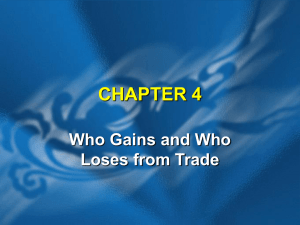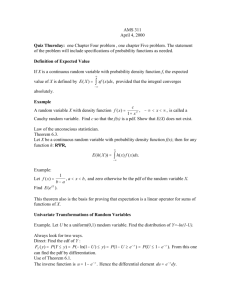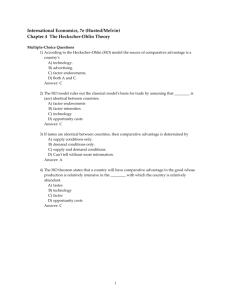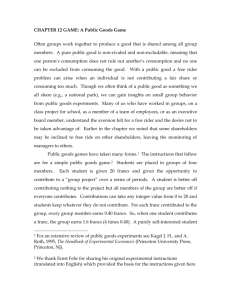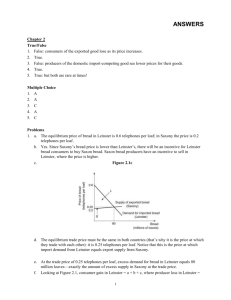Chapter 05 Study Guide
advertisement
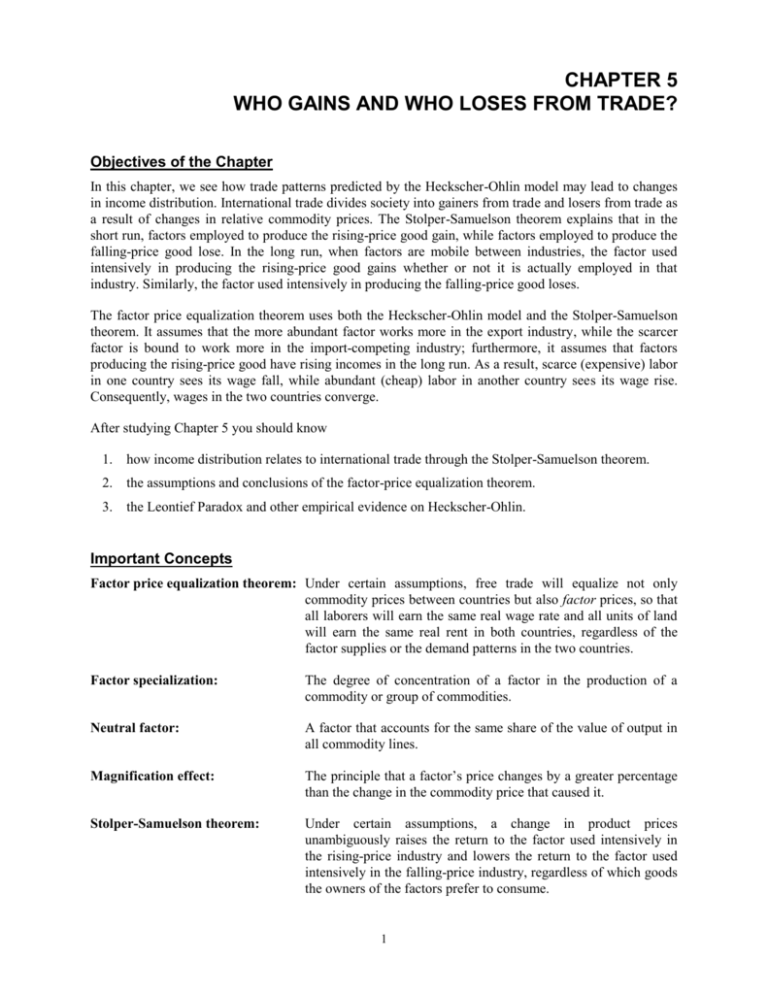
CHAPTER 5 WHO GAINS AND WHO LOSES FROM TRADE? Objectives of the Chapter In this chapter, we see how trade patterns predicted by the Heckscher-Ohlin model may lead to changes in income distribution. International trade divides society into gainers from trade and losers from trade as a result of changes in relative commodity prices. The Stolper-Samuelson theorem explains that in the short run, factors employed to produce the rising-price good gain, while factors employed to produce the falling-price good lose. In the long run, when factors are mobile between industries, the factor used intensively in producing the rising-price good gains whether or not it is actually employed in that industry. Similarly, the factor used intensively in producing the falling-price good loses. The factor price equalization theorem uses both the Heckscher-Ohlin model and the Stolper-Samuelson theorem. It assumes that the more abundant factor works more in the export industry, while the scarcer factor is bound to work more in the import-competing industry; furthermore, it assumes that factors producing the rising-price good have rising incomes in the long run. As a result, scarce (expensive) labor in one country sees its wage fall, while abundant (cheap) labor in another country sees its wage rise. Consequently, wages in the two countries converge. After studying Chapter 5 you should know 1. how income distribution relates to international trade through the Stolper-Samuelson theorem. 2. the assumptions and conclusions of the factor-price equalization theorem. 3. the Leontief Paradox and other empirical evidence on Heckscher-Ohlin. Important Concepts Factor price equalization theorem: Under certain assumptions, free trade will equalize not only commodity prices between countries but also factor prices, so that all laborers will earn the same real wage rate and all units of land will earn the same real rent in both countries, regardless of the factor supplies or the demand patterns in the two countries. Factor specialization: The degree of concentration of a factor in the production of a commodity or group of commodities. Neutral factor: A factor that accounts for the same share of the value of output in all commodity lines. Magnification effect: The principle that a factor’s price changes by a greater percentage than the change in the commodity price that caused it. Stolper-Samuelson theorem: Under certain assumptions, a change in product prices unambiguously raises the return to the factor used intensively in the rising-price industry and lowers the return to the factor used intensively in the falling-price industry, regardless of which goods the owners of the factors prefer to consume. 1 Warm-up Questions True or False? Explain. 1. T/F The Leontief Paradox may be resolved by using more disaggregated definitions of factors of production. 2. T/F The Stolper-Samuelson theorem says that trade will cause the owners of the abundant factor to receive lower real incomes, while the owners of the scarce factor receive higher real incomes. 3. T/F Nobel prizes are not given to dead economists. 4. T/F Factor prices will not be equalized by trade if technologies are not the same in all countries. 5. T/F Unskilled workers in the United States should be more opposed to free trade than skilled workers in the United States. Multiple Choice 1. Studies of U.S. trade and its effects on employment of U.S. labor show that, on average, A. trade has no effect on total wages. B. replacing imports (e.g., through protection from foreign competition) saves (or creates) more jobs than an equivalent expansion of exports. C. barring imports doesn’t have much impact on the number of jobs available in the U.S. D. foreign competition has clearly raised the unemployment rate. 2. After trade opens up, in the short run, A. all groups tied to the declining sectors lose. B. only factors used more intensively in the declining sectors lose. C. only factors used less intensively in the declining sectors lose. D. only the most abundant factor in the country loses. 3. Mexico is an unskilled-labor abundant country, while the United States is a skilled-labor abundant country. With the opening of trade, you would expect that, in the long run, wages for unskilled workers A. decline in both countries. B. decline in the United States and rise in Mexico. C. rise in the United States and decline in Mexico. D. rise in both countries. 2 4. Which of the following statements is false? A. Consumption patterns do not matter for welfare gains or losses of neutral factors. B. Consumption patterns do affect the size of the gains or losses to all factors. C. Consumption patterns do not affect the direction of gains or losses for the most specialized factors. D. Consumption patterns do not matter for the welfare gains or losses of a nation as a whole. 5. Factor price equalization will not hold if A. factors are immobile between sectors of the economy. B. factors have different productivities in different countries. C. countries put up barriers to free trade. D. all of the above. Problems 1. Recall our hypothetical trade model: Leinster is a labor-abundant country and Saxony is a land-abundant country; telephones are labor-intensive goods and bread is a land-intensive good. Assume that free trade prevails between the two countries. a. What happens to wages earned by workers in Leinster in the short run? In the long run? b. What happens to wages earned by workers in Saxony in the short run? In the long run? c. According to the factor-price equalization theorem, will labor wages in Leinster equal land rents in Leinster, or will Leinster wages equal Saxony wages? 2. Given the implications of trade models for factor prices, how would you explain an observation that, in 2009, the hourly compensation for manufacturing workers in Canada was $29.60 while in Mexico it was only $5.38? 3 3. Consider an economy producing capital-intensive computers and land-intensive wheat. Labor is employed to produce both goods. If free trade raises the price of computers relative to wheat, who would gain and who would lose under each of the following scenarios? a. Factors are perfectly immobile between the two sectors. b. Factors are perfectly mobile between the two sectors. 4. You are given the following cost data for France, where they have nothing but capital and labor and make nothing but bread and wine. capital input labor input total cost To make a loaf of bread 5 francs 4 francs 9 francs To make a bottle of wine 20 francs 10 francs 30 francs a. Is bread-making more capital-intensive than wine-making or vice versa? Explain. b. Suppose trade opens and the price of wine rises while the price of bread falls. If capital and labor were completely immobile between bread-making and wine-making, who in France would gain from the shift in prices? Who would lose? (Consider the four groups of bread capitalists, bread laborers, wine capitalists, and wine laborers.) 4 c. Which group of consumers will rejoice with the winemakers in the situation presented in Question 4b? Which group of consumers will commiserate with the breadmakers? 5. Suppose that a new isolationist government in Leinster decides to shut off the country’s imports of land-intensive bread, preferring to produce food rather than making labor-intensive telephones for export. After trade is shut off, bread becomes 14 percent more expensive relative to telephones (i.e., telephones become 14 percent cheaper relative to bread). a. Over the long run, how much, and in what direction, will isolation change Leinsterian laborers’ real wage incomes? b. Over the long run, how much, and in what direction, will isolation change Leinsterian landlords’ real rental income? Discussion Topics 1. What do you think would happen to factor prices internationally if an energy crisis tripled the cost of shipping goods around the globe? 2. Policymakers today are concerned about retraining unemployed workers. Try to make a case for such programs as a means of increasing public support for free trade. 5






